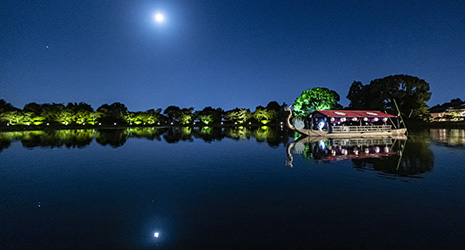September 2022
- English
- 日本語
Moon-viewing Party

Kangetsu-no-yube moon-viewing from a boat on Osawa-no-ike Pond at Daikakuji Temple 
Scene from the Mangetsu hoe (full moon ceremony) to pray for a bountiful harvest

Bow of the dragon-head boat beneath the full moon on Osawa-no-ike Pond

Every year in the fall, Daikakuji Temple in Sagano, Kyoto City* holds a Kangetsu-no-yube (moon-viewing party), when guests can enjoy the view of the beautiful moon from boats on the Osawa-no-ike Pond located in the temple grounds.

The custom of Kangetsu (moon-viewing) dates back to the early Heian period (794 to the end of the 12th century), when court nobles would enjoy looking at the full moon on a clear autumn night following the heat of summer. The aristocrats would enjoy drinking together, reciting poetry, and playing musical instruments while taking in the view of the moon from boats on the water. Continuing that tradition, the Kangetsu-no-yube (moon-viewing party) is held every year in autumn at Daikakuji Temple, located in the heart of Sagano in the northwest suburbs of Kyoto.
Founded in 876, Daikakuji Temple has historic connections to the Japanese Imperial Family**. Within its precincts, there is Osawa-no-ike Pond, known as the site of Japan’s oldest surviving man-made garden with features such as woods and miniature lakes. Designated a National Place of Scenic Beauty, the pond has a circumference of around 1 kilometer and covers an area of some 64,000 square meters. The reflection of the moon on the surface of the water on an autumn night is splendid.
“For emperors and high-ranking nobles, the moon was not something to gaze up at,” says Okamura Koshin, General Affairs Manager of Daikakuji Temple. “Rather, they gazed downward and admired the moon’s reflection on the surface of the water or in the sake cups they were drinking from.” It is a unique form of moon-viewing etiquette practiced by emperors and members of the aristocracy.
Guests at the Kangetsu-no-yube can follow this tradition and enjoy moon viewing, just as nobles did in the Heian period, from two Ryuto-gekishu-sen boats, gliding and turning slowly around Osawa-no-ike Pond, each boat decorated at the bow with the heads of imaginary creatures, one a dragon (ryu) and the other a kind of waterfowl (geki***).
“The moon shines brightly in the sky, and if you lower your eyes the same moon is reflected in the calm surface of the water below. No man-made objects enter your field of vision when you look at the moon reflected in Osawa-no-ike Pond. These two kinds of moon viewing let us immerse ourselves in nature and forget everything else,” says Okamura.
The Kangetsu-no-yube takes place in September and October over the course of three nights including the night of Chushu (Mid-Autumn). During this time, a Buddhist ritual called the Mangetsu hoe (full moon ceremony), in which the monks of Daikakuji Temple pray for a bountiful harvest, is held on a special stage extending out over the Osawa-no-ike Pond while the many visitors enjoy the clear view of the moon overhead.

Osawa-no-ike Pond is also renowned for its autumn foliage. Once the Kangetsu-no-yube is over and autumn is in full swing, from mid-November to early-December the surface of the pond reflects the brilliant crimson autumn leaves. At night, the area is illuminated, creating a magical scene.
Visitors to Osawa-no-ike Pond at Daikakuji Temple today can enjoy autumn as it was once enjoyed by Heian aristocrats.
* See Highlighting Japan August 2022, Two Paths through the Bamboo in Sagano, Kyoto https://www.gov-online.go.jp/eng/publicity/book/hlj/html/202208/202208_02_en.html
** The predecessor of Daikakuji Temple was the Imperial villa constructed by Emperor Saga in the early Heian period (Saga Rikyu-in). The grandson of Emperor Saga, Prince Gojaku Nyudo, founded Daikakuji Temple on the site of Saga Rikyu-in in 876.
*** Imaginary waterfowl, large white birds that is said to fly in the sky and skilfully dive into the water.

